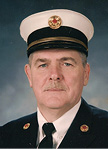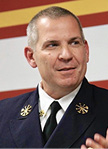Fire apparatus design and engineering have made great strides during the past 30 years. In 1994, it was not uncommon to see rigs with canopy cabs, limited compartment space, and far different hose storage options. Yet, they performed admirably. With all that in mind, we asked Advisory Board Members Bill Adams and Ricky Riley, “In the past 30 years, what is the most important apparatus innovation?”
Updating Standards Continuously
By Bill Adams

Answering this question honestly could subject yours truly to the Sword of Damocles, which means I might be exposing myself to imminent condemnation by cohorts as well as readers with good memories. It’s like swinging a double-edged sword at an object, and it springs back and bites you. In firehouse talk, I’m trying to have it both ways—a politically correct way and my way.
No single apparatus improvement warrants first place as the most important since 1994. On pages 349 to 354 in National Fire Protection Association (NFPA) 1900, Standard for Aircraft Rescue and Firefighting Vehicles, Automotive Fire Apparatus, Wildland Fire Apparatus, and Automotive Ambulances (2024 ed.), Annex G—History of NFPA 1900 are listed some noteworthy changes since 1906. Pick one of your choosing.
I have never been an enthusiastic fan of every requirement in NFPA safety standards for fire apparatus. That includes the current NFPA 1900 and the now obsolete NFPA 1901, Standard for Automotive Fire Apparatus, and NFPA 1906, Standard for Willand Fire Apparatus.
However, I agree 100% with every effort to provide safe fire apparatus to transport firefighters to and from an incident as well as for the apparatus’ performance on arrival. Being so, my answer is: The most important innovation in fire apparatus in the past 30 years is the continuous upgrading of the NFPA’s minimum apparatus standards.
Having no experience with ambulances or airport crash trucks, my comments are focused solely on apparatus formerly covered by NFPA 1901 and NFPA 1906. As mentioned, I may not personally agree with each and every change, addition, or deletion made to the apparatus standards. However, I fully support the NFPA’s continuing work in meeting the objective succinctly pointed out in NFPA 1901, Chapter 1, Administration section 1.1* Scope: “This standard defines the requirements for new automotive fire apparatus and trailers designed to be used under emergency conditions to transport personnel and equipment and to support the suppression of fires and mitigation of other hazardous situations.” Safely transporting and supporting are crucial.
FALSE IMPRESSIONS
As others in the fire service did, I used to believe the NFPA apparatus standards were developed in strict secrecy by a handful of people behind closed doors on Batterymarch Park in Quincy, Massachusetts. That is far from the case. There was a common belief that only fire apparatus manufacturers made the rules, regulations, and changes in the standards. Or, at the least, they overly influenced them. That attitude lingers today. While debatable by die hard disbelievers, until proven true that attitude is also misleading.
HOW IT WORKS
The following is my perception of the system. NFPA 1900 has three primary technical committees: one on ambulances, one on fire department apparatus, and one on aircraft rescue and firefighting. My observation is that most NFPA committee members appear tight-lipped about what they are doing. In reality, all proposed changes addressed by the technical committees are made available to the public—from submission to final resolution.
There are numerous subcommittees that address apparatus functions such as aerials, wildland, etc. and component parts such as pump, wiring, and body. To the best of my knowledge, the subcommittees and their members are not publicly listed—which is probably a good thing, or they’d be badgered constantly.
Supposedly, anyone can attend and have input at the subcommittee meetings. Interested manufacturers do attend. They can provide valuable information as to what can and can’t be done. Subcommittees are headed by members of their primary technical committees. The public is not banned from attending, nor is anyone prohibited from discussing what is transpiring. Before a proposed change is resolved, it goes through two committee processes, then to the full committee for a vote. The public has the right to comment on the record before the NFPA Standards Committee approves or disapproves it.
BLACK COAT INSTIGATED CHANGES
“Black coats” is an endearing term for rank-and-file firefighters, formerly called the people in the crew cab or before that the gang riding the back step. As in the past, black coats can instigate changes. In particular, before NFPA 1900, one black coat believed the NFPA should not be dictating how many and where ancillary equipment such as axes and spanner wrenches must be mounted on a fire truck. The black coat followed all the required NFPA guidelines to suggest changes. The NFPA formally adopted the concept.
Another proposed change made to NFPA 1900 was that the NFPA should not require quantities and types of ancillary equipment that must be supplied on various types of apparatus. Some people believed requiring how much of what type of miscellaneous equipment is required was beyond the NFPA’s purview, believing it should be a local decision. The NFPA agreed, and loose equipment is now listed in NFPA 1900 Appendix A as a recommendation or suggestion and not a requirement.
RIGIDITY OR FLEXIBILITY?
When an NFPA standard has been adopted as law by a political subdivision, a presumption could be that what the NFPA is mandating is the last and final word in the fire truck world. In some instances, the fire service has “bucked the system” by not adhering to provisions it disliked. Some years ago, the NFPA acquiesced by adding a “statement of exceptions” to the standard where both purchaser and buyer could agree in writing that some NFPA requirements could be completed before a rig was put into service rather than when it was delivered. It allowed local dealers or fire departments to accomplish the work. It also took the manufacturers off the hook liability-wise. And, it allowed some fire departments to duck undesired responsibility—albeit temporarily.
Another silent rebellion was when the NFPA mandated the colors of the livery—the reflective safety graphics on an apparatus and especially the rear chevrons. Fire departments wanted to choose the colors “they wanted” and not what the NFPA wanted. I never read the pro and con public comments and recommended changes on the subject, but the latest revision did not require specific colors—merely contrasting ones with a certain reflectivity.
After the index at the very end of NFPA 1900 are three pages describing the NFPA’s official “Sequence of Events for the Standards Development Process,” “Committee Membership Classifications,” and guidelines on submitting public comments to the NFPA. If you have a suggestion, idea, or problem with NFPA 1900, you can be part of the solution. They’re showing you how to be.
BILL ADAMS is a member of the Fire Apparatus & Emergency Equipment Editorial Advisory Board, a former fire apparatus salesman, and a past chief of the East Rochester (NY) Fire Department. He has 50 years of experience in the volunteer fire service.
Safety Advancements
By Ricky Riley

This topic could be a book of designs, innovations, and engineering that has brought fire service apparatus from where it was 30 years ago to today. The changes in the industry from the federal, state, and local mandates is a long list in itself. Couple that with firefighters’ designs and demands and manufacturers’ engineers coming up with new technology and engineering. We have come a long way in the past 30 years. I mean 30 years ago we still had canopy cab apparatus being made and delivered. Imagine firefighters today having the possibility of getting rain on them or even snow, and without climate control. But, the most important apparatus innovations I believe have come through chassis engineering and designs that have allowed for our apparatus to operate on our streets and roadways in a substantially safer manner—even though many of them are taken for granted today because of their normality for our current drivers and operators.
We can go back to 1991 when designs allowed for air disc brakes on our fire apparatus, helping us reduce stopping distances and eliminating a lot of brake fade because of the drum brakes heating—especially prevalent in busy departments that experienced high call volumes and a lot of braking because of street configurations and many stopping zones. This also helped eliminate checking brake stroke and the possibility of the units’ brakes being out of adjustment, which caused unpredictable stopping distances.
As braking technology advanced even further, we were able to add antilock braking systems (ABS) to the apparatus. This allowed units to apply maximum braking when confronted with an emergency stop or reacting to an unexpected obstacle or car. Operators could maintain control of the apparatus and even allow for steering the apparatus through the event without the lockup and out-of-control directions that a full brake lockup would produce before ABS. This pulsing of the brakes is read through the tone ring and the wheel speed sensor, telling the system when to apply brakes and when to release them based on the tone ring revolutions. Basically, when the tires slow enough to where they are locking up, the speed sensor sends a signal to release the brakes to allow better control. If you look at the skid marks from an apparatus with ABS, you can see the chattering of the marks. This is the brakes applying and releasing numerous times during the event. While I am sure that these systems caused a lot of headaches when they initially came into the field, it is easy to say it was all worth it as these systems cause very little downtime to apparatus and are very dependable—both mechanically and for safety.
Another safety advancement that greatly reduced the chance of accidents and rollovers came: electronic stability control (ESC). This system understands the apparatus better than the driver/operator does. That does not discredit good apparatus drivers, but the system takes into account a number of factors in the driving motion of the apparatus. In split seconds, the system can decipher the speed, the apparatus motion, and inertia and reduce speed automatically without the driver needing to react to the event. It can also apply brakes to allow the driver to regain control of the apparatus. This system greatly reduces the chance for accidents or worse when apparatus take corners too aggressively and even during low-friction events like sliding on ice. While ESC has helped us reduce the chance of rollover accidents, the driver and officer must also play a part in reducing them by driving responsibly and monitoring driver actions and habits. We have certainly proven that even with ESC we can still roll a fire apparatus over. Thus, the combination of technology and human actions and abilities is what can prevent these types of accidents.
The list of the many safety advancements in fire apparatus is lengthy, and while I am sure my esteemed colleague Bill Adams will have a different view, all these advancements have made the fire apparatus, emergency responses, and even daily driving safer for our firefighters and civilians each and every day. I wait for the next innovation and design from fire apparatus manufacturers that will enhance safety on our streets.
RICKY RILEY is the president of Traditions Training, LLC. He previously served as the operations chief for Clearwater (FL) Fire & Rescue and as a firefighter for Fairfax County (VA) Fire & Rescue. He also is a firefighter with the Kentland (MD) Volunteer Fire Department and a member of the Fire Apparatus & Emergency Equipment Editorial Advisory Board.

